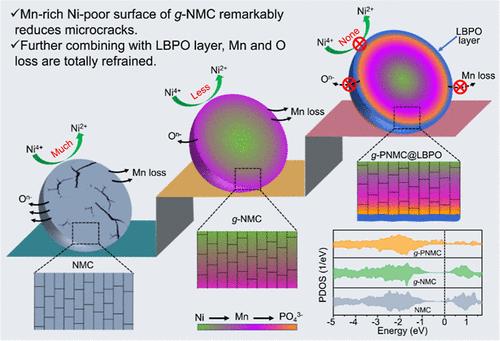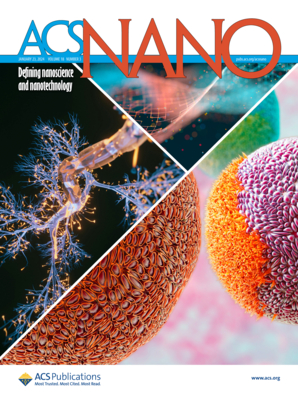富镍共贫阴极的成分梯度设计增强了高压锂离子电池的循环能力和安全性
IF 15.8
1区 材料科学
Q1 CHEMISTRY, MULTIDISCIPLINARY
引用次数: 0
摘要
本文章由计算机程序翻译,如有差异,请以英文原文为准。

Compositional Gradient Design of Ni-Rich Co-Poor Cathodes Enhanced Cyclability and Safety in High-Voltage Li-Ion Batteries
Developing cost-effective high-voltage Ni-rich cathodes has reached a consensus to replace conventional ultrahigh Ni counterparts for high-energy Li-ion batteries, but more rigorous requirements are put forward for their mechanical and chemical stability. Herein, we report the design and synthesis of a full concentration gradient LiNi0.75Mn0.20Co0.05O2 cathode with a Mn-rich Ni-poor surface, which has been realized by in situ forming a PO43– gradient distribution to retard the transition-metal ions’ interdiffusion during the high-temperature lithiation process. This design mitigates the mechanical stress concentration at the source with high morphological integrity and refrains the lattice oxygen loss under 4.5 V high-voltage operation. After Li0.1B0.967PO4 is coated, the surface parasitic reactions are further ameliorated with stable interface chemistry. The resultant Ni-rich cathodes deliver a reversible capacity as high as 212.6 mAh g–1 at 2.7–4.5 V with an energy density of >800 Wh kg–1cathode, almost equivalent to the state-of-the-art Ni-content 90% cathodes at 2.7–4.3 V. In commercial-grade full cells, a superior cycle life of 80.5% capacity retention is achieved at 1C within 2.7–4.5 V after 1700 cycles, exhibiting promising opportunities in compositional gradient design for Ni-rich cathodes.
求助全文
通过发布文献求助,成功后即可免费获取论文全文。
去求助
来源期刊

ACS Nano
工程技术-材料科学:综合
CiteScore
26.00
自引率
4.10%
发文量
1627
审稿时长
1.7 months
期刊介绍:
ACS Nano, published monthly, serves as an international forum for comprehensive articles on nanoscience and nanotechnology research at the intersections of chemistry, biology, materials science, physics, and engineering. The journal fosters communication among scientists in these communities, facilitating collaboration, new research opportunities, and advancements through discoveries. ACS Nano covers synthesis, assembly, characterization, theory, and simulation of nanostructures, nanobiotechnology, nanofabrication, methods and tools for nanoscience and nanotechnology, and self- and directed-assembly. Alongside original research articles, it offers thorough reviews, perspectives on cutting-edge research, and discussions envisioning the future of nanoscience and nanotechnology.
 求助内容:
求助内容: 应助结果提醒方式:
应助结果提醒方式:


